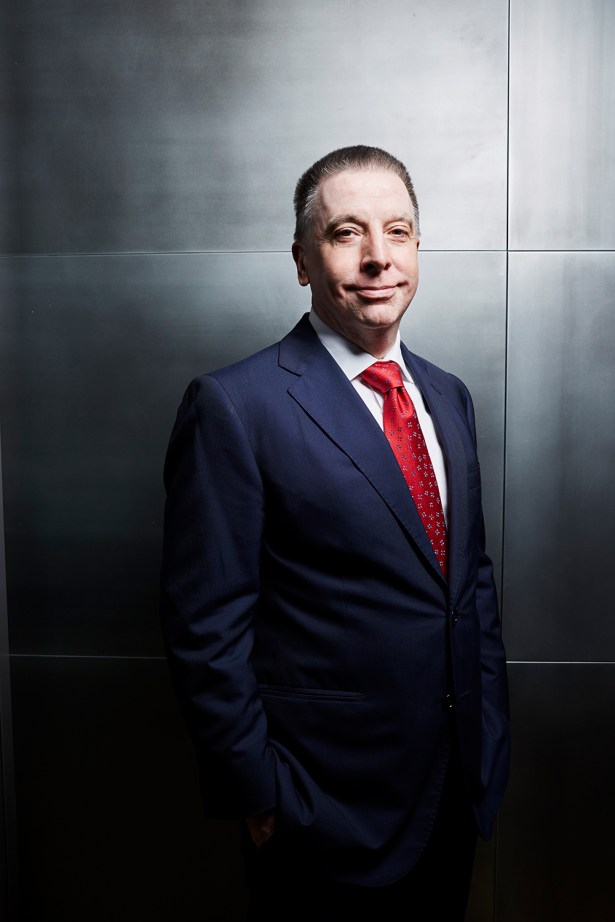The French Connection: Natixis’ Greg Murphy Is a Lender to Know
By Cathy Cunningham September 6, 2017 9:00 am
reprints
The name Natixis is at once familiar and mysterious in lending circles. On one hand, Natixis has certainly muscled its way into the trade headlines, refinancing boom-time loans and originating new ones. On the other hand, the who and what of the French bank are largely known to industry insiders only.
The “who” is Greg Murphy, the head of Natixis Real Estate Americas.
During his 17-year tenure at the bank, Murphy has originated over $35 billion in commercial mortgages and $18 billion in CMBS loans—“a team effort,” he is quick to stress, “not just me personally.”
Modesty aside, Murphy is “a very bright guy who really understands the marketplace,” said Richard Horowitz, a principal of Cooper-Horowitz, who recently worked with Murphy and his team at Natixis as part of the lender consortium behind the behemoth $1.76 billion loan on HNA Group’s $2.2 billion acquisition of 245 Park Avenue.
The loan was led by J.P. Morgan and co-originated by Natixis, Deutsche Bank, Barclays and Société Générale. A $500 million portion of the $1.2 billion senior loan was securitized in a single-asset deal, 245 Park Avenue Trust 2017-245P, with $700 million to be securitized in future transactions.
In addition to the senior loan, the financing package included $568 million in mezzanine debt, bringing the total financing to $1.76 billion.
“We brokered the loan, and Natixis took a big chunk of it. Greg was instrumental in participating in the deal, and they were involved in both the senior and mezzanine portions of the financing,” Horowitz said.
Natixis was initially interested in making the entire loan, said a source familiar with the deal who declined to be named, but a club deal was the eventual outcome.
No mean feat for a bank that “a lot of borrowers still don’t know,” Horowitz said. “When you tell them Natixis is one of the largest investment banks in France and one of the top providers of real estate financing in our business in the U.S., they’re surprised.”
But, they soon learn that Murphy and his team “take on very complex and unique transactions,” Horowitz said. “And they have the ability to structure deals that provide borrowers with tremendous access to the capital markets.”
Today, Murphy, a father of three, lives in Cobble Hill, Brooklyn. But long before his days providing multimillion-dollar loans in the Big Apple and beyond, Murphy grew up some 800 miles away in Gary, Ind.—a steel town in the Chicago suburbs—as the son of an engineer who worked for the United States Steel Corporation and later became a professor.
He attended the University of Illinois in Urbana-Champaign before getting his MBA at the University of Chicago. His first job was as a research analyst at a futures and options brokerage house, also in Chicago.
Murphy headed to New York in 1987. He worked in Salomon Brothers’ investment strategies group before joining Citibank in 1988—initially in a fixed-income research position before eventually moving to the bank’s trading desk. He got his feet wet as a residential mortgage-backed securities trader for a number of years, until the CMBS market came along in 1993 and turned his head. “I thought it looked interesting, so I asked for the CMBS trading job, and I got it.” Murphy became head of CMBS trading at Citibank in 1994.
“Real estate is just fascinating to me,” Murphy said, explaining his gravitation toward CMBS over its residential counterpart. “It’s living, it’s breathing, you can see it, you can touch it, and each property is different.”
Murphy headed the CMBS trading desks for both Chase Manhattan, from 1996 to 1998, and Nomura Securities, from 1998 to 2000, before finally joining Natixis’ predecessor, CDC, in 2000.
The CMBS market has evolved significantly since Murphy started trading bonds 25 years ago. “Back then, it was a very small market, and there wasn’t much liquidity,” Murphy recalled. “Over the years it grew before stumbling in the Russian financial crisis and the Asian financial crisis in the late 1990s. Then, from the early 2000s on, it just grew dramatically with a massive amount of liquidity and huge market share. But then the crisis occurred.”
Murphy recalls the financial crisis as “A very rough time,” during which his team shrank from 60 people to 20 people over the space of a few years.
The bank was able to weather the crisis largely due to its balance of portfolio lending and CMBS, Murphy said. “We were able to work through what bad debt we had, and we had the ability to apply our balance sheet to liquidate steadily yet intelligently. We were able to get fairly high recoveries of anything that did go bad.”
Natixis’ roots began in Paris back in 1818 with the creation of Caisse d’Epargne, a general public savings bank. Several iterations of the financial institution later, Caisse des Dépôts’ financial activities were spun off to create corporate and investment banking arm CDC IXIS in 2000, before it emerged as a global player and established a firm investment banking footing in the U.S. in 2004. Natixis was formally created in 2006.
The bank focused on portfolio lending during the leaner years of 2008 to 2010, before re-entering the CMBS market in 2010 with a splash. Together with Royal Bank of Scotland, Natixis tested the water with the first multiborrower, multi-asset CMBS deal post-crisis in April 2010, RBS Commercial Funding 2010-MB1. The $309 million deal was well received by investors and oversubscribed.
According to an article by Commercial Real Estate Direct at the time of issuance, RBS underwrote five of the deal’s six collateral loans, while Natixis contributed one. The transaction primarily comprised retail properties, which accounted for 66.3 percent of the pool.
In today’s market, retail has become a somewhat dirty word, and Natixis is eyeing the asset class with some apprehension. “I hate to be negative on retail because there is a lot of wonderful retail out there, but investors—both on the CMBS side and the co-lending, syndication side—are very wary. So we’re selective in where we’re playing in retail,” Murphy said. While urban retail and the necessity-based, value-based and convenience-based retail sectors are strong in the lender’s eyes, enclosed malls are a no-go.
Although construction loans are another scarcity—especially in markets such as New York City, where there is a fear of oversupply—Natixis hasn’t shied away from construction loans…on the right projects.
David Rubenstein, the founder of real estate investment firm Rubenstein Partners, has known Murphy for 10 years, but the first transaction that the two joined forces on was the construction financing of 25 Kent Avenue in Brooklyn. “It was a case of [Murphy] matching the flexibility that we needed with the protection that his bank needed,” Rubenstein said of the transaction’s consummation.
Rubenstein Partners’ Fund II, together with Toby Moskovits’ Heritage Equity Partners, acquired 25 Kent Avenue—an 80,000-square-foot land parcel in Williamsburg, Brooklyn—in December 2015. The site is being developed into a 500,000-square-foot building with office, industrial and retail uses and will open for occupancy in summer 2018.
Natixis took down one half of the $197 million construction loan for the buzzed-about East River Waterfront property, and Wells Fargo the other half.
“We always thought Greg was creative and flexible,” Rubenstein said. “He doesn’t just tick a box, in terms of, ‘Does this work or not work for Natixis?’ He considers the risks of the deal and what the appropriate returns are that Natixis needs to get for the risk it is taking.”
At the time of the deal’s closing, Jeremiah Kane, Rubenstein’s director for New York City, told CO, “Both Wells and Natixis demonstrated a commitment to spending the time and effort to understanding a new office market.”
Although construction lending has slowed significantly, Kane said the appeal for the lenders came down to Rubenstein’s track record in developing offices along the East Coast, as well as the project’s location. “We believe that the site is perhaps the best location in Williamsburg: waterfront, incredible views, directly adjacent to the five new hotels either open or about to open in the area, close to parks. And the lenders agreed,” he said.
“Markets are telling you that you should be cautious,” Murphy said of construction lending. “It doesn’t mean that you shouldn’t do construction loans—we’re still lending but we’re cautious and choosing specific projects that we think occupy a unique niche in a market. We’re still active, but we’re selective.”
Lenders’ caution on the construction side of the market, reflected in their preference for existing properties, is actually “very healthy,” said Murphy. “If construction loans are more difficult to get or higher priced, only the better projects will get done, and that should have an effect on supply-demand relationships. The market seems disciplined, which is a very good sign.”
Today, Natixis’ balance of portfolio versus CMBS lending “ebbs and flows,” Murphy said. However, while it’s held steady at around 50-50 over the past two years, in 2017 it has been weighted more heavily, 65-35, toward “CMBS-related” originations.
“I say ‘related’ because one of the very interesting aspects of the market just recently, in the past six months, is the interest by many different investors—both domestic and foreign—in subordinated debt,” Murphy explained. “So, we’ve been making a lot of loans—especially on the larger side—that we divide into a pretty substantial subordinated debt portion and a securitizable senior portion.”
The strategy addresses two investor interests, he said. CMBS investors are looking for lower loan-to-value transactions, while investors in sub debt are looking for high quality properties with good tenancy, yet in exchange for quality, they’re accepting what historically has been a relatively low yield. The bank is therefore providing all-in financing options for borrowers. “It’s a win-win-win,” Murphy said.
Natixis has been a particularly active player in the CMBS market. In April, it provided a $250 million fixed-rate, first mortgage CMBS loan to JEMB Realty to refinance 75 Broad Street in Lower Manhattan. JEMB had been a prior client of Natixis on the power and infrastructure side of its lending business and the bank securitized the loan in a single-asset, single-borrower deal. “It was a fine deal,” Murphy said. “Good for the borrower and good for us.”
In May, a few steps away at 85 Broad Street, Natixis financed Ivanhoe Cambridge’s acquisition of the property with a $360 million CMBS loan, then issued the first “green” CMBS rake tranche backed by the property in July. The $72 million tranche, part of the CSAIL 2017-C8 CMBS transaction, was met with strong demand from U.S. and overseas investors.
And most recently, it provided a $270 million, five-year, fixed-rate loan to refinance a JW Marriott hotel in downtown Chicago (a portion of which has been securitized in the UBSCM 2017-C3 CMBS transaction).
Natixis’ lending footprint and strategy extends far beyond New York state lines. The lender recently provided a $233 million loan for the acquisition of Crossroads III, a 349,758-square-foot office property in Sunnyvale, Calif., fully leased to Apple, again portioning the debt into investor-pleasing chunks. “We carved off a pretty substantial subordinated debt portion of $128 million and broke that into a couple of pieces, selling it as mezzanine and B-notes, and put the low LTV senior piece into a couple of different CMBS transactions,” Murphy said. “We’ve done that in a number of large deals.”
Investors’ appetite for subordinated debt isn’t a new phenomenon, although the type of investor has changed. A few years ago high-yielding debt was the goal with domestic debt funds leading the hunt, but over time a number of different domestic and international buyers have stepped up to the plate. (See story on page 22.) Today, they’re seeking lower-levered subordinated debt on higher quality assets with lower yield hurdles, Murphy said. “It’s made the sub debt market very liquid. It’s also brought yields lower overall in the sub debt market.”
As for where those investors are hailing from? “We’ve sold to Korean investors, Chinese investors, Israeli investors…There’s definitely an interest on all sides of the market,” Murphy said. “I think it started with interest from foreign investors in buying properties. But that’s now evolved into a lot of these players wanting to have debt exposure to real estate as well as the equity exposure to real estate.”
Of the many industry changes he’s experienced during his 30-year career, one of the biggest is the advent of risk retention.
“You need to have the financial wherewithal to hold your own risk, and that’s a substantial commitment of capital. The makeup of originations and issuances has changed dramatically, really pushing business toward the larger, well-capitalized banks.”
For now, Murphy and his team are spending some time figuring out what the next trends will be.
“What are investors looking for versus what are borrowers demanding? We’re trying to hit on that. There is a lot of demand on the borrowing side for medium-sized floating-rate debt, say, $10 million to $50 million in financing that is needed on transitional properties. That market hasn’t been very liquid over the past few years, and there is substantial demand on the borrower side. Now we’re seeing substantial demand on the investor side for yield and a higher sophistication in foreign investors, so we think there may be a way to marry these two and that demand,” Murphy said.
“Part of it will be using our portfolio as a transitionary place for the loans or perhaps keeping senior portions of them and distributing subordinated debt on the smaller loans.”
As for what’s coming down the pipeline in term of transactions? Murphy is maintaining the mystery. “We have several deals in the works,” Murphy said. “But as usual, it’s CMBS, so we can’t talk about it.”

Yvonne Albinowski/For Commercial Observer


